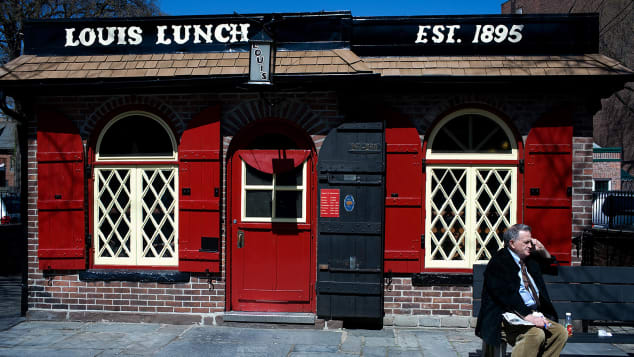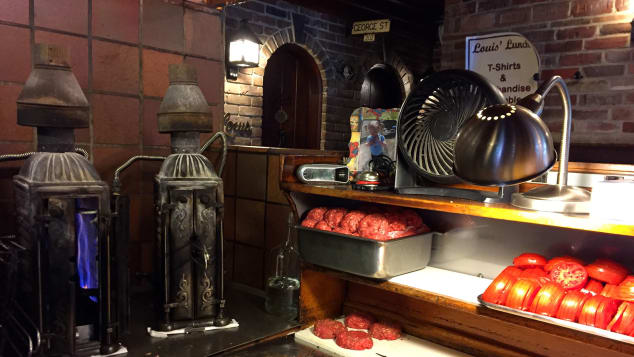
(CNN) — Whether you’re in the heartland of the United States or halfway across the world, when you crave an American meal, you’re probably sinking your teeth into a hamburger.
While most Americans can’t remember a time without them, hamburgers only started to become widely popular in the United States roughly a century ago.
Few burger restaurants from that era continue to serve burgers made with meat ground fresh daily. Fewer still also serve those burgers the way they were made back in the day.
George Motz, a burger scholar of sorts, has dedicated more than 20 years of his life to traveling across the United States researching hamburgers. After producing, shooting, editing and directing his 2004 documentary film “Hamburger America,” Motz went on to publish a state-by-state burger guide, and later his first cookbook, “The Great American Burger Book,” in 2016.
Most recently, he hosts Burger Scholar Sessions on Complex Media’s “First We Feast,” which is in its fourth season on YouTube.
“I like to say I’ve eaten more hamburgers in more places than you have,” Motz said.
We’d have to agree: Motz estimates he’s probably eaten some 20,000 burgers in his life, with no plans to stop anytime soon.
During his travels, Motz has found burger joints that continue to sling their burgers like they did over a century ago.
While such establishments remain few in contrast to their countless fast food chain counterparts, they hold a key to America’s hamburger history.
Motz has shared five of the classics with CNN Travel. But first, a bit of hamburger history.
How the hamburger became an American classic
The hamburger has a well-traveled history.
According to Motz, the hamburger’s origin story starts in 13th-century Mongolia when Mongols and Tatars were fighting.
“Apparently, the Tatars had a taste for raw mutton. They would ride all day long with raw mutton under their saddles. When they finally set up camp, they would take this raw, warm mutton, chop it up, probably add some spices or something, and eat it that way.”
The dish eventually made its way to ship workers and ports lining the Baltic Sea, which allowed it to reach more westward parts of Europe including Scandinavia.
From there, it finally made its way to Germany and the port of Hamburg. When it made it to Germany, many centuries later, the dish shifted from raw mutton to chopped cooked beef, which is known today as frikadellen.
Motz explained that as German migrants waited for their ships, they ate frikadellen as a cheap and tasty meal option. When they left Hamburg for the US in the mid-19th century, migrants brought knowledge of the dish with them.
“Frikadellen eventually made its way to the United States, and I can imagine the frikadellen meant nothing to most people who were living in the US unless you were German. So they had to change the name at that point to ‘steak in the style of Hamburg,’ or simply, Hamburg steak.”
As German migrants moved westward across the United States to farm, state fairs also began popping up.
Farmers from all walks of life would attend these fairs to learn about different agricultural practices and equipment. According to Motz, German migrants set up their own stands serving Hamburg steak, which was considered an ethnic food at the time.
While hot dogs predate hamburgers as fair food, Motz says he believes the hot dog inspired several places to eventually start putting Hamburg steaks onto bread, making them Hamburg sandwiches, and eventually the hamburger
No one can say for sure who did it first.
“There were about 7 to 9 claims all throughout the Midwest, Texas to Ohio to Wisconsin, too many claims. Unfortunately, there’s no way to definitively prove who first put Hamburg steak onto a bun,” Motz said. “It happened everywhere at the same time, and nobody was reporting on it.”
Carrying on an American classic
The trend caught on, and restaurants starting serving the sandwiches. Hamburgers are now a point of pride in American cuisine, Motz said.
“The hamburger is pretty much the only food invention in America in the last 100 years or so. It started out as ethnic food from Germany, but we adopted it and made it different by putting it on bread.”
Having withstood the tests of time, from the Great Depression to Covid-19 and everything in between, some early burger restaurants remain standing today.
Whether you’re doing a road trip or a hamburger pilgrimage, here are five burger joints still serving fresh, original American hamburgers to visit in the United States:
Louis’ Lunch (New Haven, Connecticut)

Among the oldest joints serving classic burgers is Louis’ Lunch in New Haven, Connecticut.
Now in its fourth generation of ownership, this family-owned restaurant has been serving customers since 1895.
Using meat ground fresh daily, Louis’ Lunch cooks its hamburgers vertically (yes, you read that right) in their three upright cast-iron broiler stoves dating from 1898.

Held in a grill basket, the burgers are slid into the stoves and cooked by flames on both sides.

Choosing your hamburger isn’t complicated either. “The Original Burger” is your only option, served on white bread. To enhance the meat flavor, the only garnishes you can add are onions, cheese and a slice of tomato. If you’re hoping for ketchup, you’ll need to go elsewhere!